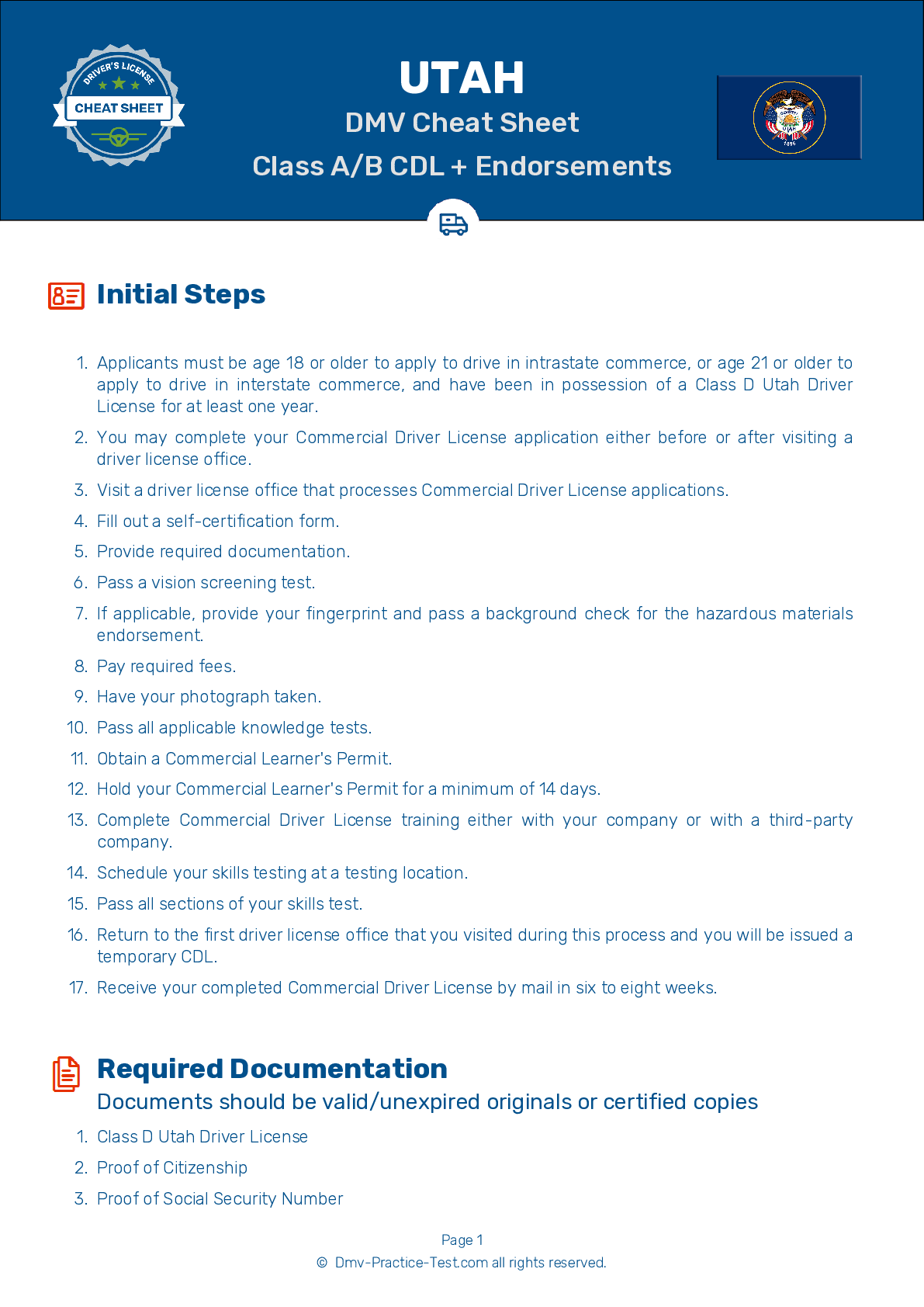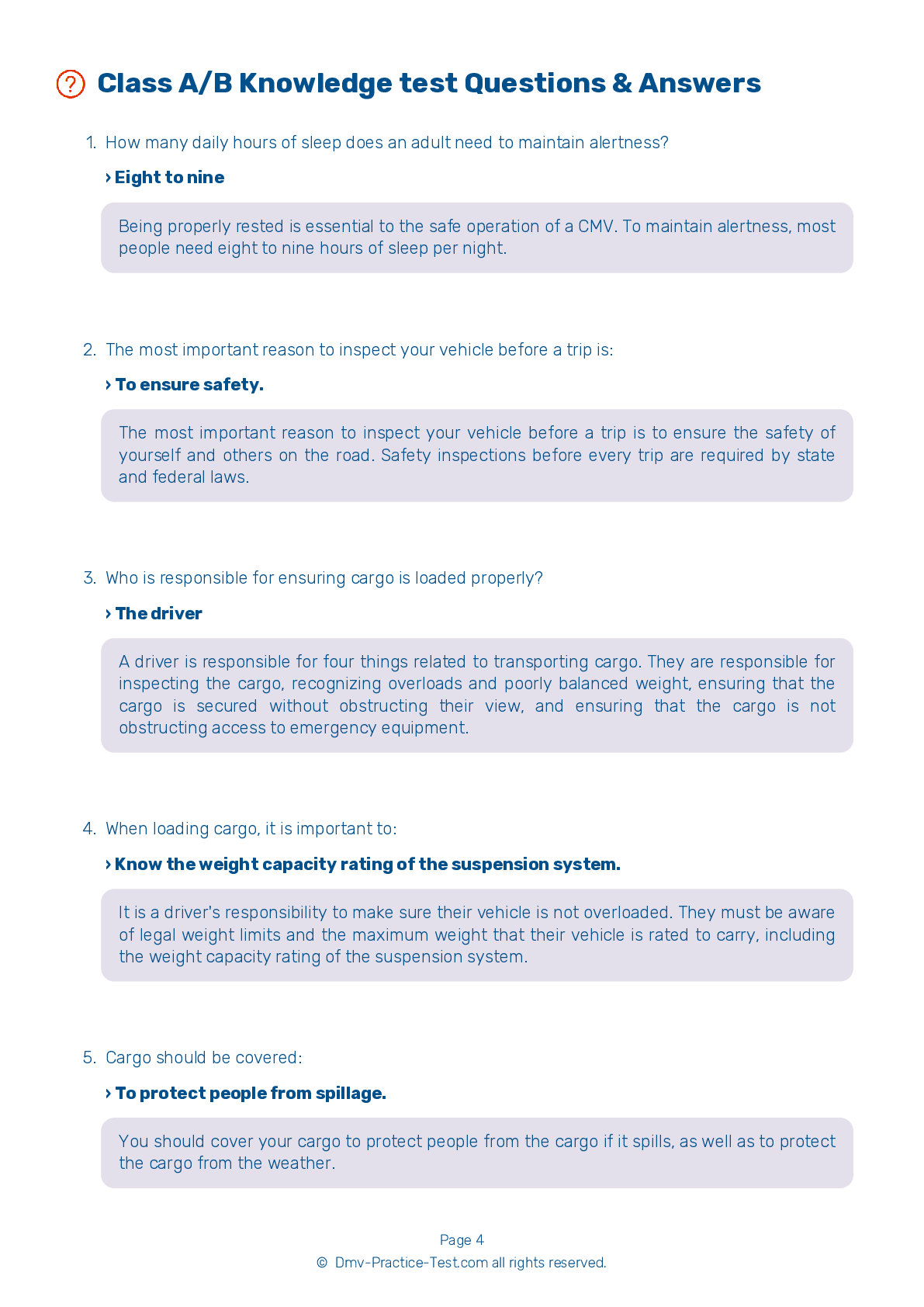Double #1
Double Triple Test | Utah 2025 #1 Page 2 of 3
Train for FREE with our Utah CDL double triple practice test online. The official exam test consists of several obligatory parts, with all of them checking your knowledge of different blocks of road rules. If you need to obtain a UT CDL double triple license in 2025, practice as much as possible. Free sample tests published on our website will help you check and improve your knowledge and boost your grades. Please bear in mind that DMV requirements may vary from state to state.
20
16
20
8 . Which of the following statements is correct?
Welded repairs are acceptable for wheels on rear axles.
Missing clamps, spacers, studs, or lugs can be a dangerous defect. Mismatched, bent, or cracked lock rings are not safe to be used. Wheels or rims with welded repairs are not safe.
9 . What should be done shortly after a tire has been changed?
The driver should inflate the tire.
After changing a tire, you should stop after driving for a while to recheck the tightness of the lug nuts.
10 . Rough acceleration:
Should be used to prevent rust from forming.
Always accelerate smoothly and gradually so that your vehicle does not jerk. Rough acceleration can cause mechanical damage.
11 . Which of the following is not required safety equipment?
All commercial motor vehicles are required to be equipped with the proper emergency equipment. This may include spare electrical fuses; three red reflective triangles, six fuses, or three liquid burning flares; and at least one properly charged and rated fire extinguisher.
12 . The person responsible for the safe transport of cargo is the person loading cargo.
The driver of a vehicle is responsible for the safe transport of its cargo, regardless of who loaded the vehicle.
13 . A broken exhaust system can allow poisonous gas to enter the cab.
A broken exhaust system is extremely hazardous because it can permit poisonous fumes to enter the vehicle's cab or sleeper berth.
14 . Drivers may use ____ red reflective warning triangles when their vehicle is stopped on the side of the road.
Seven
If a vehicle carries red reflective triangles, the driver should place three of them as warning devices when the vehicle is parked on the road.
2025 Utah | Frequently Asked Questions
To acquire a CDL Hazmat endorsement in Utah, you must first have a valid Utah CDL. Then, pass the Hazardous Materials Endorsement Knowledge Test, submit to a federal background check and fingerprinting by the Transportation Security Administration (TSA). Finally, you must pay the required endorsement fee. It's recommended to study the Utah CDL Handbook beforehand.
To obtain a CDL Hazmat license, you must have a valid Commercial Driver's License (CDL). You should be at least 21 years old, have a clean driving record, and pass a physical examination. Additionally, you must pass the Hazardous Materials Endorsement Knowledge Test and a TSA background check. It's also important to be proficient in English for reading and speaking.
When applying for a CDL Hazmat endorsement in Utah, you'll need to provide your current CDL, proof of U.S. citizenship or legal presence (like a passport or birth certificate), social security card, and proof of Utah residency. You'll also need to complete the HAZMAT endorsement application and pass the TSA background check.
Yes, there is a dedicated written test for the CDL Hazmat endorsement. It's known as the Hazardous Materials Endorsement Knowledge Test. This test assesses your understanding of the rules and regulations related to transporting hazardous materials. It's recommended to study the relevant sections in your state's CDL handbook before taking the test.
The written test for the CDL Hazmat endorsement covers a variety of topics including: understanding and identifying different types of hazardous materials, rules for safe loading and unloading, proper use of placards and labels, emergency response procedures, and specific regulations regarding the transportation of hazardous materials. It's crucial to study these areas thoroughly.
Yes, there are extra charges associated with acquiring a CDL Hazmat endorsement. In Utah, the endorsement itself costs $9.00. However, you'll also need to pay for a TSA background check, which costs $86.50. Please note these fees are subject to change and it's always best to check the latest fee structure with the Utah Driver License Division.
Yes, a background check and security clearance are required for a CDL Hazmat endorsement. The Transportation Security Administration (TSA) conducts this check, which includes fingerprinting and a review of your criminal history. If you pass the background check, TSA provides a security threat assessment to your state's licensing agency.
Yes, obtaining a CDL Hazmat endorsement requires specialized training and passing a written test. The training covers handling hazardous materials, safety procedures, and emergency protocols. After the training, you must pass the Hazmat endorsement test to demonstrate your understanding of these areas. You also need to pass a TSA background check.
No, it's illegal to transport hazardous materials without a valid Commercial Driver's License (CDL) with a Hazmat endorsement. This endorsement ensures the driver is properly trained and knowledgeable about handling and transporting hazardous materials safely. Driving without the necessary endorsement can result in hefty fines and penalties.
Yes, you can add the CDL Hazmat endorsement to your current CDL license. You don't need to apply for a new CDL. However, you'll have to pass a written test specific to hazardous materials and undergo a TSA background check. Once these are successfully completed, the endorsement will be added to your existing CDL.



